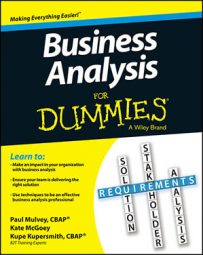Several tools facilitate urgent transfer and delivery of messages in business analysis. These choices are good for situations where you can’t be face-to-face in the moment but still need someone’s real-time attention:
Text messaging: Great when you just need to share information quickly or ask an immediate yes/no/opinion question that really can’t wait.
Chat or instant messaging: The electronic equivalent of sticking your head into someone’s office. It’s a helpful relationship builder for remote colleagues, but if your question is more than one or two lines long or the chat will take more than two minutes to complete, switch to phone (or e-mail, if the matter requires less-immediate attention).
Phone calls: Tone of voice plays a significant role in communicating effectively, so picking up the phone is the best way to go when you can’t meet in person but need to discuss a potentially sensitive topic, convey understanding, or build teams and strengthen relationships.
When you need to communicate directly with a specific person but immediate connection isn’t possible or appropriate, try one of the following:
Voicemail: Great for getting an important message or question delivered to a specific individual with appropriate tone of voice.
Most voice mailboxes are private, but this setup isn’t always the case. When in doubt about privacy, leave a brief, general message that conveys the topic and requests a return call.
E-mail: Useful for longer messages, sharing attachments, and tracking communication history. E-mail often gets information and some media transmitted most quickly, but actual communication speed depends on how frequently the recipient checks or receives e-mail and her initiative and interest in writing back.
Postal mail (snail mail): Useful in situations where a hard copy is important — like if special paper, binding, or color printing is needed —or you need the recipient to sign and return papers. If documents are long, stakeholders may find reading a physical document more convenient than an electronic one.
Some tools are built for group communications, allowing people to correspond at their convenience without an influx of e-mails. Recipients connect when they have time and desire. Be aware that a delay occurs between posting and receiving information, so these tools aren’t ideal for time-sensitive messaging:
Message boards: One person posts a message or question, and others respond. Good for discussions on specific, single-topic items, for issue and risk management, and for gathering feedback on specific requirements prior to decision-making.
Social networking tools: Corporate/inter-office/private networks similar to message boards. However, they feature multimedia and significantly more interaction. They’re terrific for relationship-building and idea-generation.
When you need to share information with large audiences but discussion is less appropriate, these one-way communication tools may be effective:
Public broadcast television or radio: Despite being used very infrequently in the business analysis world, these media can be still helpful in getting a message out to public audiences where appropriate. You can recommend using these options to solicit potential focus group members, request volunteers for market research or solution user testing, or to distribute particular marketing messages.
Video: Video is useful for getting info out to large audiences while incorporating tone of voice and body language. It’s especially useful during times of managing change because it’s great for building situational understanding, communicating commitment, inspiring solutions and implementation efforts, and ensuring that all audiences get the same message.
Webinar or web conference: With or without a video component, these options are great for building understanding, commitment, or action. They’re useful for change efforts, as well as solution demonstrations, requirements walk-throughs, or information previews. They can be tailored to small or large audiences and can include document display and multimedia. Although audience participation is possible in webinars, large audience discussions are difficult to manage without a special producer.
In some circumstances, you may need to communicate with people who are hearing-impaired. Tools such as captioned telephone, teletypewriter (TTY) or telecommunications relay services (TRS) can help.

